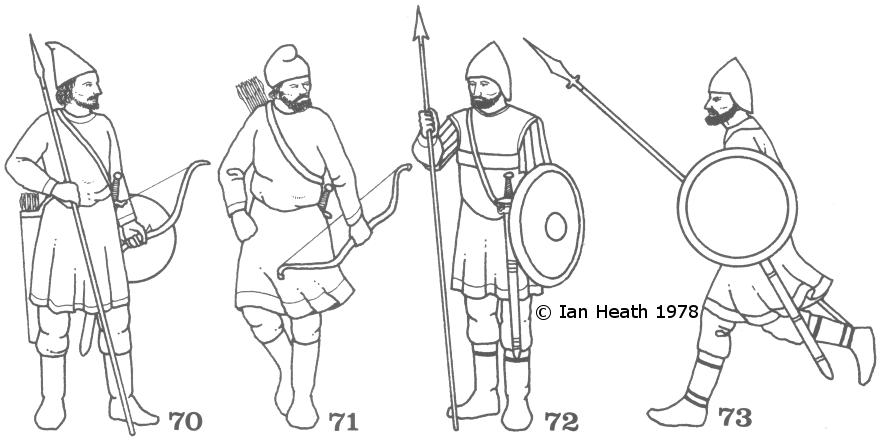
Try Amazon Audible Plus
BYZANTINE LIGHT INFANTRYMEN
An extract from Armies and Enemies of the Crusades 1096-1291by Ian Heath



70, 71, 72 & 73. BYZANTINE LIGHT INFANTRYMEN
Light infantry continued to constitute a fair percentage of Byzantine foot soldiers, some continuing to resemble the traditional types described under 6, 7 and 8 in 'Armies of the Dark Ages' (Anna Comnena, for instance, describes light infantry armed only with bow and small shield). Others were slingers and some were crossbowmen (called Tzangratoroi). After apparently falling out of favour in the 10th century the crossbow (Tzangra) was reintroduced under Frankish influence during the 12th century; when Anna wrote her Alexiad c. 1140-1150 she still described the crossbow as 'a weapon of the barbarians (Franks), absolutely unknown to the Greeks' and felt it necessary to give a detailed description of it, which would suggest that its use was not widespread even then (though she is describing Frankish crossbowmen of the First Crusade). However, it is mentioned in use during Manuel's reign (1143-1180) and certainly it was in general use by the end of the century, Isaac of Cyprus' army in 1191 apparently including a considerable number of crossbowmen. It frequently occurs in 13th century sources.
Most light infantry, however, were archers or, to a lesser extent, javelinmen. 70 and 71 are both armed with composite bows, though 70 (c. 1100) carries in addition a spear. 71, from the Scylitzes ms., carries no shield; he is probably one of the light-armed Anatolian provincial troops (Paphlagonians and Bithynians in particular) held in high regard by the Byzantines during this period, especially in Nicaean armies of the 13th century - there were Bithynian archers at Pelagonia in 1259, for example, and at Galata in 1260, while 800 elite Bithynian archers were the nucleus of the army with which Alexius Strategopoulos recaptured Constantinople in 1261. His cap is characteristic of both Bithynians and Phrygians (that of 70 is similar).
The spearmen depicted in 72 and 73 are probably fairly representative of the light-armed ex-Thematic provincial levies and the infantry contingents of the Stratiotes. These two date to the 12th and 13th centuries respectively, but similar figures are to be found throughout this era. Both wear helmets of similar design and carry circular shields about 2 feet in diameter. 72 in addition wears a leather corselet with reinforcing breastband and pteruges at the shoulders. Scylitzes shows many such unarmoured infantry spearmen with kite-shields in place of round ones.